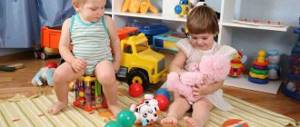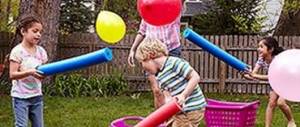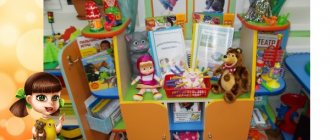Play activities of children of the younger group
Municipal preschool educational institution
CRR kindergarten No. 51 “Sun”
"Game activities of children of the younger group"
Educator:
Azarova O. E.
In early childhood, when everything human is just beginning to form in a person, the cultivation of good feelings acquires special importance.
In Russian psychology and pedagogy, it is customary to distinguish junior, middle and senior preschool ages. Each age period is associated not only with further development, but also with a significant restructuring of the child’s cognitive activity and personality, necessary for his successful transition to a new social status - the status of a schoolchild.
At the age of 3, the child gradually leaves the family circle. His communication becomes non-situational. An adult becomes for a child not only a family member, but also a bearer of a certain social function. The child’s desire to perform the same function leads to a contradiction with his real capabilities. This contradiction is resolved through the development of play, which becomes the leading activity in preschool age.
The main feature of the game is its convention: performing certain actions with certain objects presupposes their attribution to other actions with other objects. The main content of the play of younger preschoolers is actions with toys and substitute objects. The game duration is short. Younger preschoolers are limited to playing with one or two roles and simple, undeveloped plots. Games with rules are just beginning to take shape at this age.
In early preschool age, imagination begins to develop, which is especially clearly manifested in play, when some objects act as substitutes for others.
Sensory skills are being improved. The child makes no attempts to examine the object or feel it. When asked what the subject is, the children do not answer. A three-year-old child is no longer able to only take into account the properties of objects, but also to assimilate some generally accepted ideas about the varieties of these properties - sensory standards of shape, size, color and others. They become images, standards with which the characteristics of perceived objects are compared.
The predominant form of thinking becomes visual - figurative thinking. The child is able to combine objects not only by external similarities (shape, color, size), but also to assimilate generally accepted ideas about groups of objects (clothing, dishes, furniture). The basis of such ideas is the unification of objects that have a common purpose or are included in a general situation. In early preschool age, perceptual activity develops.
Conscious control of behavior is just beginning to emerge; In many ways, a child’s behavior is still situational. At the same time, one can also observe cases of the child himself limiting his own motives, accompanied by verbal instructions. Self-esteem begins to develop, and children are largely guided by the assessment of parents and other adults. Their gender identification also continues to develop, which is manifested in the nature of the toys and stories they choose.
Thus, benevolence manifests itself in goodwill, sympathy, sympathy, and beneficence. From a moral point of view, benevolence is a human duty. Goodwill emphasizes not only the unconditional recognition of another person’s moral dignity, but also expresses peacefulness, friendliness, and readiness for fruitful cooperation.”
The content of the games we offer provides for the formation in children of the knowledge and skills necessary for friendly communication, the development of good manners, which is called a culture of communication. During such games, we sought to bring children to what we consider the main thing - a feeling of belonging to a peer group. Also, their content is aimed at attracting attention to the partner, his appearance, mood, actions, deeds; The main method is direct interaction. In the process of games, the child learns to become aware of himself, his individuality, his self-esteem, preferences and capabilities, and individuality develop. With the help of games and exercises, children learn their distinctive features, children's knowledge about the gender characteristics of boys and girls, and their personal qualities is enriched. For example, the following topics are offered: “My name”, “Who is “I”?”, “My toys”, “My favorite fairy tales”, “I want, I can, I can”, “My mood”.
To form friendly relationships in young children, it is necessary to select games and exercises to develop a feeling of sympathy towards peers, to develop the ability to understand the individuality of other children. Through games, children will learn to sympathize with each other and interact with each other in play activities. The following topics are offered: “It’s bad to be alone”, “We are different”, “We have fun, laugh, play”, “We speak with our hands and body”, “Help each other”, “Boys and girls”.
The game is the strongest emotional factor, the center of aesthetic experiences, the environment for the formation of personal qualities and communication skills. To develop in children the norms of social behavior, the ability to negotiate, and take into account each other’s interests, game interaction is organized based on kindness, sympathy, and mutual assistance on the following topics: “We will quarrel and make peace,” “What is good, what is bad,” “Let’s talk.” ", "Visiting a fairy tale", "Communication lessons", etc.
Through a certain plot, content and role during the game, the moral and social feelings of preschoolers can be formed. A necessary condition for this is the modeling of relationships in which humane feelings are manifested. An example is the game "Bus". Here children act both as family members and as passengers. The number of seats on the bus is limited, so it becomes necessary to give up your seat to passengers in need.
Here it is important to give advice to parents about organizing trips with their children on public transport, introducing generally accepted norms of behavior, paying special attention to actions that showed sensitivity, attentiveness, and politeness.
At the same time, in the group, the teacher can read books of relevant content and conduct conversations. When using acceptable methods of leadership, all this will have a positive effect: children will try to be polite not only in the game, but also in life.
The most favorable games are those in which humane manifestations are included in the role instructions: “Family”, “Hospital”, “Ambulance”, as well as games whose plot requires children to be able to act together, make decisions together, and find a way out of their situations: “ Captains", "Builders", etc.
Before organizing role-playing games to solve problems of forming friendly relationships, you need to do preliminary work:
1) reading fiction that describes any typical situation containing a moral meaning, followed by a discussion of the actions described in them;
2) examination of pictures reflecting various situations from the lives of children, in which the child experiences anxiety, pain, grief, and resentment;
3) games-exercises in which children are offered solutions to situations containing moral meaning.
The selection of paintings, works of art and situations is carried out based on the plots of the games that the children will play. Special game situations are introduced into the games, allowing changes to be made to the plot that would require children to demonstrate humane feelings and relationships with their peers.
Growing up in a younger group, a child acquires the ability to watch peers play, ask them for something, and thank them. But he still needs to master forms of polite address. Children use them mainly in activities organized by adults, or when they play a particular role in a game. Not everyone knows how to indicate in a timely manner to help each other, to coordinate their actions. Very few people show organizational skills.
For example, in role-playing games, a friendly attitude towards peers, a desire to help, and an attentive attitude to the failures of others are cultivated. Situations to enrich the plot:
- Visiting the bear. The bear is going to greet guests: a bunny, a doll Masha, a little fox-sister. The bear is preparing to welcome guests. The children help him cook soup and set the table. The bear greets the guests, everyone says hello. Guests come with gifts. They sit down at the table, the bear treats its guests. They say affectionate, kind words to each other. Then a game is offered. We take an object and, based on its properties, find a similar one in terms of a given property (color, shape, tactile sensation, etc.). Then everyone says goodbye and Mishka sees off his guests.
The teacher draws the children's attention to the condition of the sick doll, that it needs care, help, and care. Encourages children who sympathize, empathize, and show care.
– We are visiting a sick doll. Doll Masha got sick. She is very sad. The children feel sorry for her, try to cheer her up, bring her gifts, look after her. They are organizing a small concert. The doll is recovering.
The adult explains cause and effect. Then you can ask your child:
– A child cries if... (tease, push, scold...);
– A child smiles if...(praise him, stroke him, smile..);
– You can’t tease a child...(he will cry...);
- If you take away the toy, (he will get angry, offended...);
– If you give him a toy, (he will smile, play with you...)
- “Guess what the mood is.”
The adult shows the child photographs or pictures where the child laughs, cries, looks thoughtfully, smiles slyly, gets angry and names these states first in the form of a verb (you are crying here, laughing, sad, rejoicing...), and then in the form of an adjective (you are sad here , cheerful, thoughtful, cunning...)
Afterwards, the adult invites the children: “Let’s show how we are happy, angry, sad,” and encourages the child to mimic emotions.
Conducting role-playing games teaches children to perform different roles, communicate and interact based on both interests. For example, you can assign different behavior traits to dolls: Bunny is a playful, cowardly person, Masha is confused, Mishka is brave and strong, mom’s helper.
During the game, children's independence, creativity, and respect for toys and each other are supported. Friendly play is encouraged: calling by name, affectionately, being attentive to peers and their requests, offering all possible help, caring for each other, mutual assistance in play, helping in cleaning up toys.
Children's play activities should take place in comfortable and safe communication; Children are given the opportunity to independently apply new experiences in gaming activities: reinforcing the rules of the game or improving their communication skills.
The content of the games we offer provides for the formation in children of the knowledge and skills necessary for friendly communication, the development of good manners, which is called a culture of communication. During such games, we sought to bring children to what we consider the main thing - a feeling of belonging to a peer group. Also, their content is aimed at attracting attention to the partner, his appearance, mood, actions, deeds; The main method is direct interaction.
In the process of introducing new content into the role-playing game, children try to independently find a way out of the situation. We only help if difficulties arise, drawing children’s attention to the results of their joint actions, preventing negative manifestations in children’s behavior, and attracting the opinions of the children themselves.
As a result, the children of our group become open, emotional, love to communicate with us, with the children, organize games themselves, sometimes quarrel, but more often they play together. Children trust us.
And this is correct, because a favorable emotional and psychological climate is unthinkable without friendly, trusting communication between children with each other, with the teacher, assistant teacher, in whom the child hopes to find support, understanding and sympathy.
Guidelines:
1. Collect your kids' favorite games. This is a special value that can accompany them for many years.
2. A new game (good) is the best gift for children, it is a new relationship experience, additional joyful minutes.
3. The game is voluntary. Don't force a game on your children if you think it's useful and they don't like it.
4. The emotional state of the teacher must correspond to the activities offered to children. A funny game does not tolerate a boring or indifferent face of the teacher.
5. The game is a diagnostic tool. The child reveals his good and not so good side. We observe, reflect, but do not use the information received to the detriment of the child.
6. No disciplinary action against children who violate the rules of the game. This is just an excuse for a friendly conversation, when children analyze, figure out who showed themselves in the game and how, and how the conflict should have been avoided.
In conclusion, let us remember the words of the great Pestalozzi that in order to realize his talents in the future, a child must have the opportunity to constantly be busy with interesting things. I really want there to be more goodness on planet Earth! I really want them not to be late with this main question! I really want us to be able to cultivate a special kind of moral purposefulness: let children remember goodness, forget evil and insults, let them learn in childhood that goodness, love, is wiser and stronger than evil.







